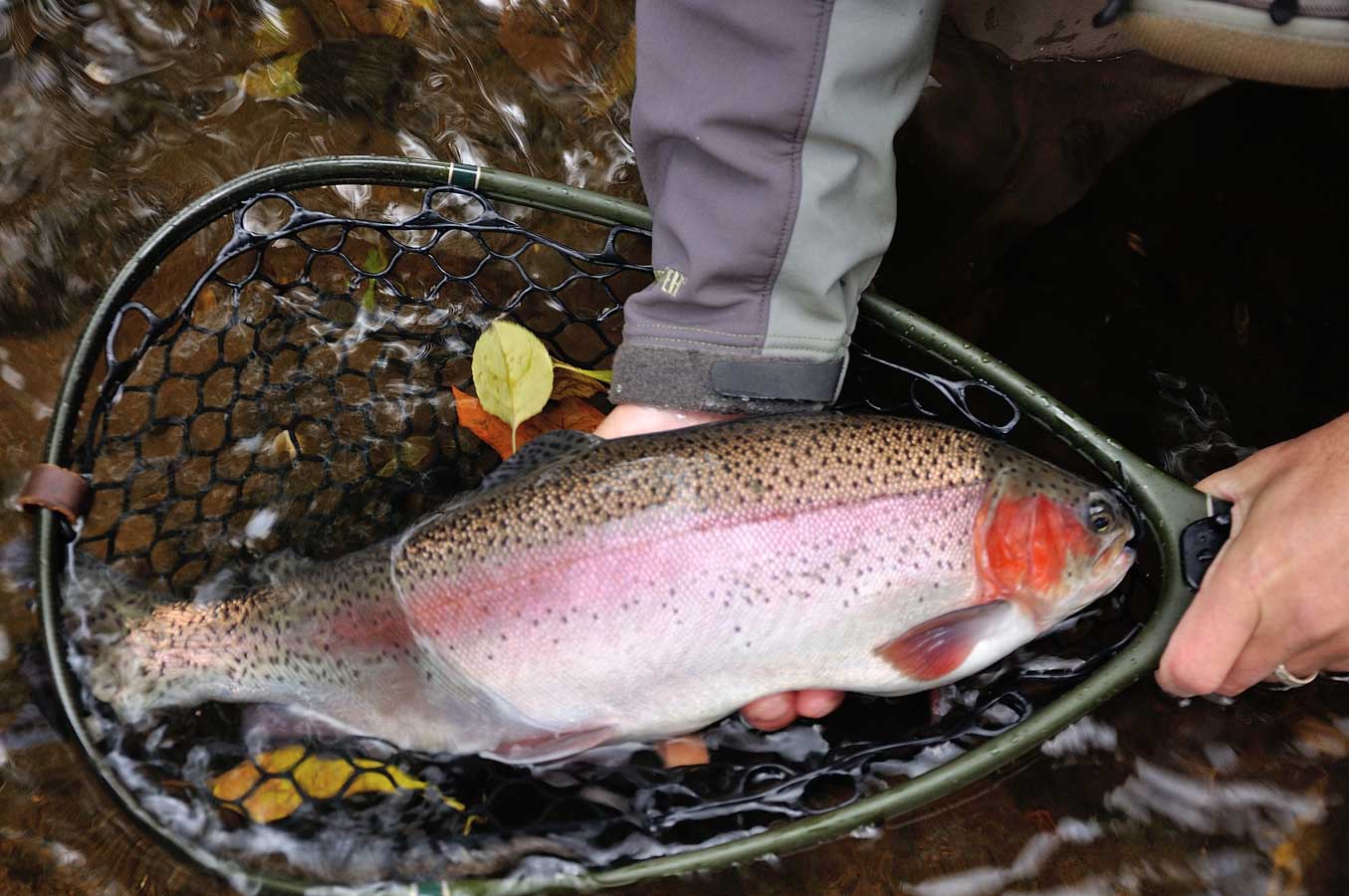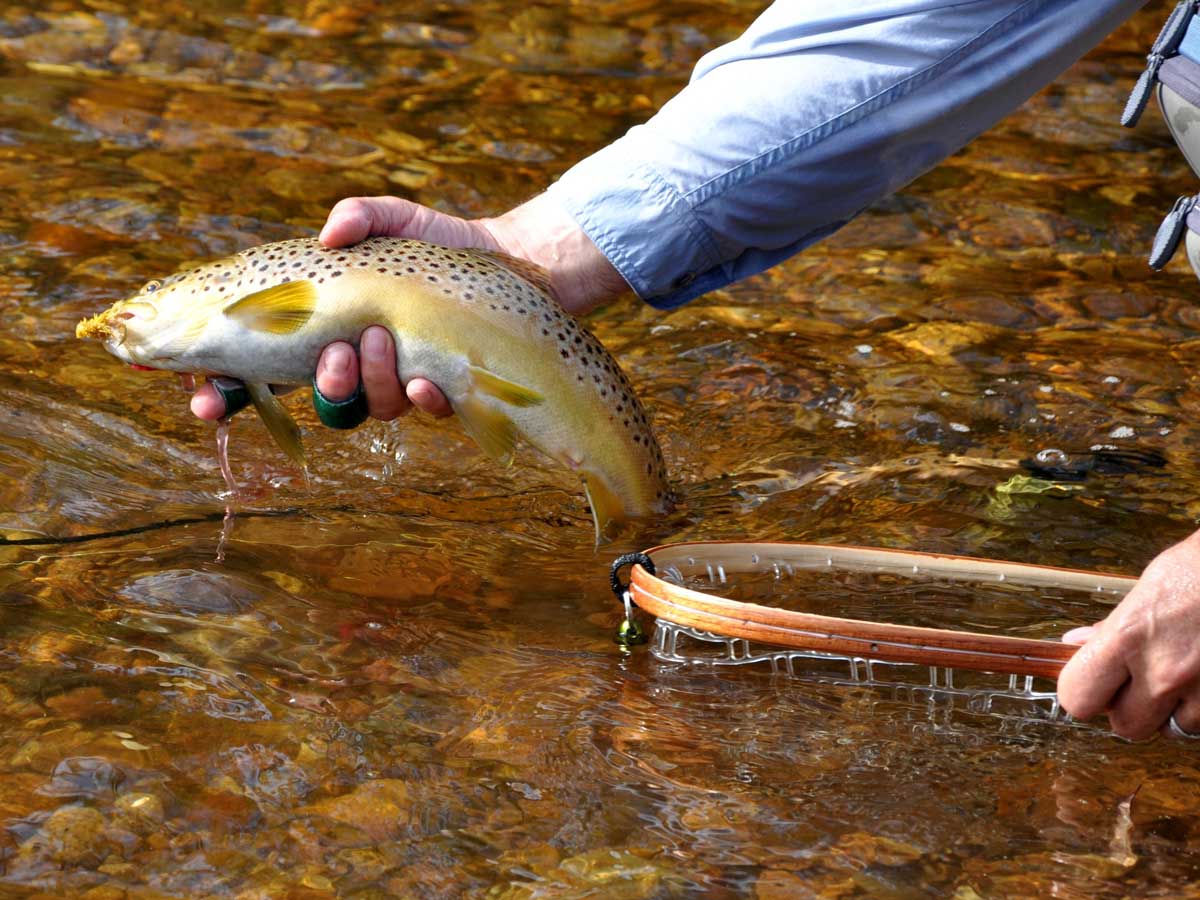Private Stocking: A Public Problem

An outsized nonnative rainbow trout-stocked by a local fishing club | Diana Mallard photo
Editor’s Note: This is the fifth article in our series on fly fishing conservation. This series appears with the support of Swift Fly Fishing, makers of Epic Fly Rods.
How many know that in some states you can stock pretty much whatever you want in a private pond, and without notification, regulation, or oversight, and regardless of any potential impact to public waterways? How many know that in some states, the same holds true in regard to stocking fish directly into a public water?
Where there are rules and oversight, stocking your own pond often requires nothing more than a mailed-in request followed by a permit that is issued without question or a site visit to determine the potential impact. And the same holds true for stocking public waters: often all that is required is a permit from state fish and game that is issued without any real consideration.
When it comes to public waters, when there are rules in place in regard to stocking and they are not followed, the perpetrator is rarely fined and is often allowed to continue what they were doing under a permit issued after the fact. In some cases, they are asked to stop, but even this is often done sans any fine or mitigation requirement.
In general, the rules in regard to private stocking vary from state to state, and even within states in some cases. For example, only brook trout can be stocked in certain parts of Maine, while nonnative brown and rainbow trout stocking is allowed in others. And the rules can vary depending on the type of water body being stocked – moving water or stillwater. Or whether the water is on private or public property. Often the rules for stocking are hard to find.
Private stocking—it is done by landowners, businesses, clubs, and organizations. It can involve trout, bass, crappie, perch, sunfish, goldfish, koi, and even baitfish. It is done for recreation (fishing), commerce (pay-to-fish or bait sales), events (tournaments and classes), aesthetics (viewing), or because someone wrongly thinks it’s good for the environment.
While man made ponds are the most common target for private stocking; natural lakes, ponds, rivers, and streams are stocked as well. And many man made ponds outlet into natural waterways. Private stocking is done on private property as well as public property, and many waters on private property flow into public property.
And to be clear, while ownership and trespass laws regarding rivers and streams vary radically from state to state, even when favorable to landowners, they are usually limited to the shoreline and in some cases streambed, leaving the water itself in the public domain. And in many cases, the movement of stocked fish is not curtailed.
The problems associated with private stocking are many, and include those resulting from state-sponsored stocking. Competition for food and space, disease, viruses, parasites, genetic swamping, and the accidental establishment of nonnative species are all possible. And of course, fish never stay where you put them, and high-water events often allow fish to escape from what are otherwise landlocked waters.
Another issue regarding private stocking is where the fish come from. While some state fish and game agencies offer fish for sale for private stocking, most of the fish associated with private stocking are purchased from private sector “fish farms.” To be fair, this doesn’t mean that these businesses are not careful, but it doesn’t mean they are either. In states like New Hampshire, once you’ve been approved to sell fish in the state, you are not subject to audits or inspections.
Another, and less obvious problem, is that state fish and game agencies are a monopoly, and breed for traits such as hatchery yield and “catchability.” This results in high levels of domestication, which in turn results in lower survivability rates in the wild, a good thing. Conversely, commercial fish farms operate in a competitive environment where aesthetics and survivability are important selling points. As a result, their fish have a better chance of naturalizing or successfully breeding with wild fish.
Who’s Doing What?
An analysis of several years of stocking permits issued by New Hampshire Fish and Game showed that many recorded private water stocking events were done by landowners and associated with both primary and second homes. Businesses, mostly hospitality related, stock as well. So, do fishing clubs and even so-called fish conservation organizations.
In many cases, public water was stocked by fishing clubs formed almost solely to do so, businesses that benefit by such, or believe they do, and even TU chapters which stocked for local recreation purposes and in support of chapter-sponsored events.

A nonative brown trout stocked by a local TU chapter | Diana Mallard
In one case, after being censured by national TU for stocking over wild native fish, while the chapter ceased stocking, a prominent member and local business owner picked it up and ran with it. Another New Hampshire TU chapter stocked a public stretch of river in support of a “Recreational tournament.”
In one of the more egregious cases, trout from a private sector fish farm were stocked in a public waterway in New Hampshire, that while stocked by the state, is home to wild native brook trout. While the name on the permit was an individual, the fish were stocked on property owned by an exclusive hotel. The purpose listed on the permit was “Stocking for a large group.” A simple Google search determined that the permittee was an executive from the parent company, and it’s fair to say the large group was associated with a party or event of some sort.
Fishing clubs are notorious stockers of both private and public water. Some even maintain their own hatcheries. I know of one water in the Mid-Atlantic where a local business and club stocks large nonnative rainbows and browns just downstream from a wild native brook trout population. I have encountered what I know to be club stocked fish in many other states as well.
A Case Study
New Hampshire has just three rivers recognized under the National Wild and Scenic Rivers System. With just 38 miles or river designated state-wide, this represents a mere 3/10ths of 1% of the state’s total river miles. Roughly 18 of those miles are designated as “Scenic,” the rest “Recreational.” At just short of 14 miles, the Wildcat River system represents roughly 37% of the total miles, and 75% of those designated as Scenic.
For years, the Wildcat River was being stocked by New Hampshire Fish and Game (NHFG) even though it had a robust wild native brook trout population. After several years of trying to get the Wildcat River included under New Hampshire’s faltering Wild Trout Management program, and regardless of the fact that it far exceeded the documented inclusion criteria in all sections surveyed, Native Fish Coalition (NFC) had to settle for a suspension of stocking above a natural barrier on the lower river.
After several years of unsubstantiated claims, NFC started to receive reputable reports of nonnative rainbow trout being caught from the upper Wildcat River. When notified by NFC, NHFG acknowledged that if true, this was a problem, but admitted they knew nothing about it. NFC did their own research, and based on where the fish were being caught, it became clear they were coming from a small private pond associated with a hospitality business. The pond in question drained into a small tributary of the Wildcat River that is included under the Scenic designation.
With no stocking permit on record, NFC reported it to NHFG. For political reasons, NHFG worked with the local TU chapter rather than NFC to look into the purported illegal stocking. NFC’s assertion proved to be correct, and the business owner admitted to having stocked the pond for several years. NHFG, TU, and the business owner worked out a deal where the pond could continue to be stocked after installation of a grate at the outlet, but with brook trout as opposed to rainbow trout. And no fines were assessed.
To be clear, while rainbows pose a threat to the river due to the possibility they could naturalize, as well as competition for food and space, and the potential that the private sector farm-raised fish could introduce disease, parasites, and viruses, switching to brook trout is in some ways worse. Specifically, it will be harder to detect escapement in the future, and in a way, we are back where we started. While a grate will help, high water events could easily compromise its effectiveness.
Anything Goes
As far as I can tell, anyone can stock pretty much anything they want anywhere they’d like to in Pennsylvania. This didn’t surprise me as while in the state on a couple of book projects, my hosts often spoke of their private stocking programs on public water as if this were the most important thing they were doing. It’s so bad, even state fish and game can’t tell you what is stocked where.
Pennsylvania is home to numerous exclusive fishing clubs located on streams that while on private property, flow in and out of public land. Fabled Spruce Creek, known as the “The Trout Stream of Presidents,” has several such clubs. While I could not find any mention of stocking on club websites, several pictures showed outsized trout with ragged and even clipped fins.
A June 2019 article in the Pittsburgh Post-Gazette stated that, “In January, commissioners added the stream section [on Spruce Creek] to its list of Class A Wild Trout Streams, a high-quality designation indicating native trout reproduction.” It went on to say, “Spruce Creek is not stocked by Fish and Boat, but many of its private owners legally stock their parts of the stream with trophy-size hatchery trout and feed them with nutrition pellets.”
The following comes from a June 2020, article that ran in Second Nature Outdoors, a Pennsylvania outdoors blog, “[PA Fish and Boat Commission] is considering a new statewide stocking permit that would be required for anyone releasing fish obtained from non-PFBC hatcheries.”
This admits that there are really no rules today. And the use of the word “considering” is disappointing, as “doing” would be far more appropriate when you consider what’s at stake here.
Pennsylvania even has a “Cooperative Nursery” program where the Fish and Boat Commission provides technical assistance, as well as eggs, fry, and fish, to organizations that want to stock. The stated goal of the program is to “provide increased fishing opportunities for public angling,” “provide sporting groups with an educational opportunity in culturing fish,” “provide educational institutions the opportunity to incorporate fish culture into their educational curriculum, and ”support local groups’ initiatives to provide fish for special events.”
So, What’s the Big Deal?
In Pennsylvania, the spread of gill lice, a form of crustacean referred to as copepods, has been linked to privately stocked fish. Gill lice can inhibit fish’s ability to breathe, and in severe cases of infestation can prove fatal. It is especially problematic during periods of drought and warm water which are already stressing fish.
An August 2018 article in Everybody Adventures stated the following: “Gill lice first showed up in Pennsylvania in 2016 during a routine survey of Wolf Run in Centre County.” It goes on to quote a Pennsylvania Fish and Boat Commission (PFBC) biologist who says, “The lice were abundant,” while referring to them as a “show stopper” due to their abundance.
As to how the gill lice got into Wolf Run, according to the article noted above they entered the system via trout stocked by a fishing club. Per PFBC, “The club depopulated its nursery, meaning it killed all it[s] remaining fish,” and that they hoped it would “end the problem.” Note the reference to “nursery,” which implies that the club raised these fish themselves.
Unfortunately, according to the article, “The same sportsmen’s club that stocked [Wolf Run] put fish in nine other [streams].” PFBC surveyed the nine other streams as well, and according to a biologist, “All contained trout with gill lice.” The only thing that may have prevented the gill lice from spreading even further, is the fact that all ten streams empty into a river impacted by acid mine drainage, and likely uninhabitable to trout.
While nonnative rainbow trout have been found to have gill lice, the impact seems especially hard on native brook trout. In 2016, one stream in Pennsylvania that was not related to the ten noted above was surveyed and found to have 150 native brook trout in a 500 meter section. In 2017, after gill lice had been discovered, a follow-up survey yielded just four brook trout, two of which had gill lice.
According to the article, the director of the Pennsylvania Fish and Boat Commission’s Fisheries Bureau stated that all of the streams where lice have been encountered had been stocked with trout purchased from commercial hatcheries. But the hatcheries were not named, as they were never inspected to confirm the presence of gill lice, and apparently, PFBC doesn’t have the authority to do so.
The problem of public stocking is real, and real dangerous from an environmental standpoint. Even where restricted to man made ponds, escapement is always a possibility, especially with the increase in high-water events and their severity we are now experiencing. When stocked in rivers and streams, the sky’s the limit as fish have access to potentially miles of water, as well as other tributaries.
I have seen privately stocked fish in public water in Colorado, Idaho, Montana, New Hampshire, New Jersey, North Carolina, Pennsylvania, Virginia, and Wyoming. In some cases, I encountered them on top of wild native fish, or within striking distance of such. And I suspect this is just the tip of the iceberg.
We don’t, and wouldn’t, allow the masses to deliberately release wildlife into our woods, so why do we let them release fish into our water? The reason is simple, we do not see our waters as the delicate and complicated ecosystems that they are. When it comes to husbandry, nothing comes close to what is happening with regard to fish. We allow sportsmen, businesses, and others to move fish around, and for self-serving reasons. And the people we need to reel it in, pun intended, are the same people who not only allow and enable it, but lead the stocking charge – state fish and game agencies.
This article appears with the support of Swift Fly Fishing, makers of Epic Fly Rods.











